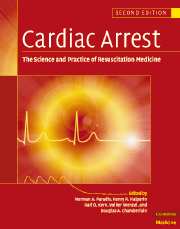Book contents
- Frontmatter
- Contents
- List of contributors
- Foreword
- Preface
- Part I Introduction
- Part II Basic science
- Part III The pathophysiology of global ischemia and reperfusion
- Part IV Therapy of sudden death
- Part V Postresuscitation disease and its care
- Part VI Special resuscitation circumstances
- 52 Prevention of sudden death in patients at risk: channelopathies and arrhythmic syndromes in the structurally normal heart
- 53 Pediatric cardiopulmonary resuscitation
- 54 Resuscitation in elder persons
- 55 Asphyxial cardiac arrest
- 56 Hemorrhagic shock and hypovolemic cardiac arrest
- 57 Cardiopulmonary resuscitation in hypothermic patients
- 58 Cardiac arrest due to poisoning
- 59 Cardiac arrest during anesthesia
- 60 Resuscitation of the pregnant patient suffering sudden cardiac death
- 61 Drowning
- 62 Anaphylactic shock
- 63 High altitude resuscitation
- 64 Electrical injuries
- 65 Rare syndromes, commotio cordis, sudden death in athletes
- Part VII Special issues in resuscitation
- Index
53 - Pediatric cardiopulmonary resuscitation
from Part VI - Special resuscitation circumstances
Published online by Cambridge University Press: 06 January 2010
- Frontmatter
- Contents
- List of contributors
- Foreword
- Preface
- Part I Introduction
- Part II Basic science
- Part III The pathophysiology of global ischemia and reperfusion
- Part IV Therapy of sudden death
- Part V Postresuscitation disease and its care
- Part VI Special resuscitation circumstances
- 52 Prevention of sudden death in patients at risk: channelopathies and arrhythmic syndromes in the structurally normal heart
- 53 Pediatric cardiopulmonary resuscitation
- 54 Resuscitation in elder persons
- 55 Asphyxial cardiac arrest
- 56 Hemorrhagic shock and hypovolemic cardiac arrest
- 57 Cardiopulmonary resuscitation in hypothermic patients
- 58 Cardiac arrest due to poisoning
- 59 Cardiac arrest during anesthesia
- 60 Resuscitation of the pregnant patient suffering sudden cardiac death
- 61 Drowning
- 62 Anaphylactic shock
- 63 High altitude resuscitation
- 64 Electrical injuries
- 65 Rare syndromes, commotio cordis, sudden death in athletes
- Part VII Special issues in resuscitation
- Index
Summary
Appropriate pediatric CPR differs from that in adults, because children are anatomically and physiologically different from adults. In addition, the pathogenesis of the cardiac arrests and the most common rhythm disturbances are different in children. In contrast to adults, children rarely suffer sudden ventricular fibrillation (VF) cardiac arrest from coronary artery disease. The causes of pediatric arrests are more diverse and are usually secondary to profound hypoxia or asphyxia due to respiratory failure or circulatory shock. Prolonged hypoxia and acidosis impair cardiac function and ultimately lead to cardiac arrest. By the time the arrest occurs, all organs of the body have generally suffered significant hypoxic-ischemic insults.
Importantly, children of various ages exhibit developmental changes that affect cardiac and respiratory physiology before, during, and after cardiac arrest. For example, newborns undergoing transitional physiological changes during emergence from an environment of amniotic fluid to a gaseous environment certainly differ from adolescents. Similarly, newborns and infants have much less cardiac and respiratory reserve, and higher pulmonary vascular resistance than do older children. Moreover, many children who experience in-hospital cardiac arrest have pre-existing developmental challenges and other organ dysfunction. Finally, pediatrics is developmental medicine, and pediatric neurological tools that are appropriate at one age may not be accurate or valid at another age.
Perhaps the most profound difference between child and adult cardiac arrest is the devastating effect of the death of a child on a family. Coping with a sudden unexpected death is always difficult. When the victim is a child, the loss tends to be even more oppressive. We do not expect children to die before their parents and thus are not prepared for it.
- Type
- Chapter
- Information
- Cardiac ArrestThe Science and Practice of Resuscitation Medicine, pp. 937 - 959Publisher: Cambridge University PressPrint publication year: 2007
- 2
- Cited by

